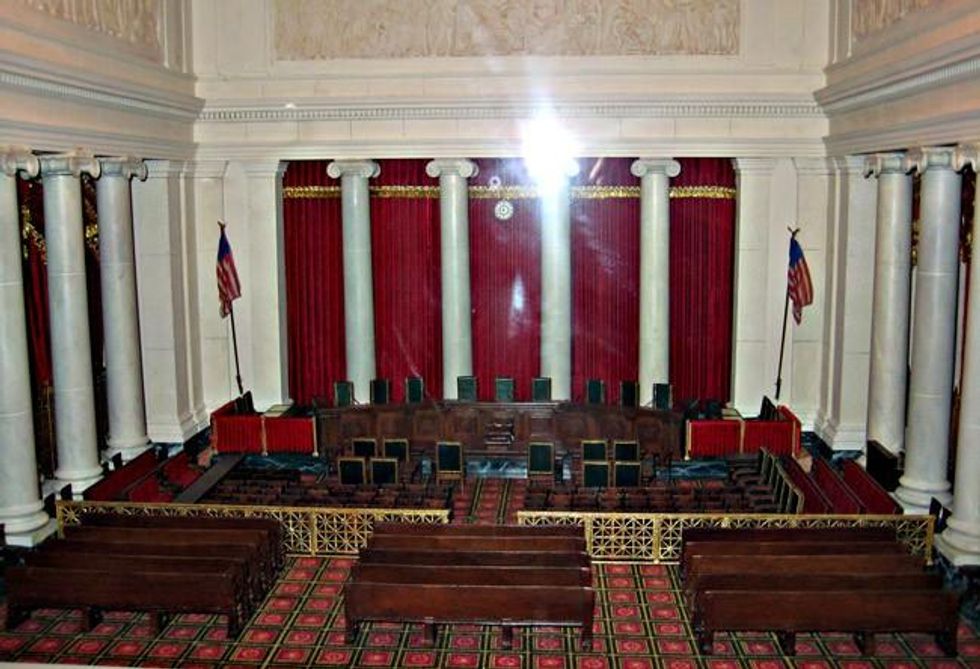Since Monday, the United States Supreme Court has been arguments for its case of the national health law. The question at the heart of the case is whether it's constitutional to force people to buy health insurance or pay a fee if they don't. It's the most anticipated and the most important Supreme Court case since Bush v. Gore in 2000.
And you won't get to see it, ever. Or hear it live, because even as the justices of the Supreme Court presume to be interpreting the law of the land for at least the next generation, they continue to live in a medieval world of their making by refusing to allow cameras in the courtroom, or even a live audio feed.
That's absurd. Whatever you may think about the health care law, for or against, there should be no dispute over lifting the veil on the Supreme Court. Every argument justices make against cameras is weak, speculative or demonstrably false--exactly the sort of arguments they would deride as sitting judges hearing a flabby case.
"If you introduce cameras," Justice Anthony Kennedy said, "it is human nature for me to suspect from time to time that one of my colleagues is saying something for a sound bite." So what? Hours of historic court arguments shouldn't be held hostage to fear of the occasional sound bite. Justice Oliver Wendell Holmes wrote in nothing but sound bites even before the invention of television. He knew it, too. The law is not the poorer for it. To the contrary. Justice Antonin Scalia, who's never had anything good to say about mob rule, was perfectly happy to let the mob make this decision for him: "For every 10 people who sat through our proceedings gavel to gavel," he told Congress in 2011, "there would be 10,000 who would see nothing but a 30-second take-out from one of the proceedings." Why should that 10,000 have precedence over the 10? And where is Scalia getting that self-serving math from?
Here's some embarrassing math. There are just 400 seats in the justices' courtroom. Just 50 seats are reserved for people waiting in line. The rest are controlled by court staff, the two sides doing battle, the media, while almost a quarter of the seats are controlled by the nine justices, who give them away in a weird little game of patronage. There's also a gallery where people can file in for three-minute glimpses of the robed ones in action. You'd think they were wearing the shroud of Turin or that this was Stonehenge, not the highest court of a technologically cutting edge and supposedly democratic nation.
For years members of Congress made the same arguments against letting cameras in. It would cheapen their proceedings. Lawmakers would grandstand. People wouldn't watch. None of those arguments trumped the people's right to see their government in action, as Brian Lamb, C-Span's founder and visionary, well knew (Lamb announced his semi-retirement effective April 1). The very first television broadcast of the U.S. House of Representatives took place at high noon on March 19, 1979, when C-Span went on the air for the first time. The House debated something about shipping lottery tickets to foreign countries. A dozen members of the House made their usual one-minute speeches. A few formalities took place at the beginning and the end. And that was it. The republic survived. Seven years later, the U.S. Senate opened its chamber to TV cameras, mostly thanks to the persistence of the late Sen. Robert C. Byrd, the West Virginia monument.
Courts caught on. Every state court system, including state supreme courts, now allows cameras in. Justice hasn't suffered. It's become more transparent. Florida's supreme court justices are not less august or less respected for broadcasting their oral arguments live on the Florida Channel. They're merely less snobbish about it.
Ironically, the justices have been recording their oral arguments since 1955. They never let on until Peter Irons, a legal scholar, discovered the recordings at the National Archives in the early 1990s and packaged some of them for sale in 1993: Roe v. Wade, Miranda v. Arizona, the Pentagon Papers case--you could finally hear them all. As scratchy as they sound, and as difficult as it may be to make out which justice is saying what, they're the intellectual equivalent of a George Lucas flick: it's hard to turn away. Yet in another display of judicial snootiness, the court tried to stop Irons from selling what amounts to recordings of public proceedings. It backed down, and now all oral arguments going back to 1955 are available on the web.
This year the court agreed to release audio of arguments at the end of each week's arguments, and in the case of the health care law they've agreed to release the audio at the end of the day (as they did with Bush v. Gore). It's an improvement. But it's not enough. These nine justices need to get over themselves. The Supreme Court isn't their court. It's the people's court. Turn off the arrogant stuffiness, turn on the live cameras and let the 21st century in.

